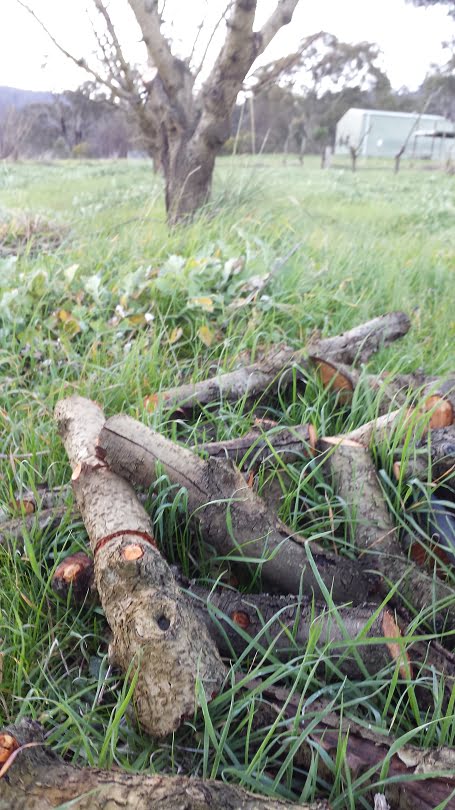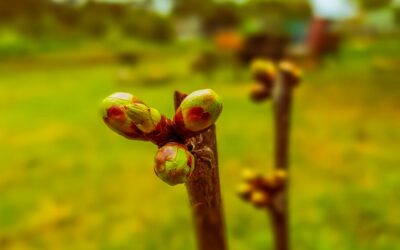Estimated reading time: 6 minutes
What do you do with your fruit tree prunings?
Prunings are on our minds because during autumn the farm is usually in full-on apricot pruning mode. The typical stunning, warm autumn weather we get in our part of the world makes it the perfect time for the job.
Summer pruning fruit trees
When the trees are starting to wear their glorious autumn colours, it’s an absolute joy to be in the garden and hanging out with them.
Pruning is a great time to do a close-up health check of your fruit trees. If your apricot tree is like the ones on our farm, you might see the odd spot of Gummosis or the remnants of this year’s Blossom blight infection.
Summer pruning is a good opportunity to remove this kind of diseased wood from the tree. In fact, it’s so important that it’s the first step in our foolproof 7-step pruning method.
But then what?

Disposing of fruit tree prunings
Picking up diseased prunings and disposing of them properly is just as important as the pruning itself.
The best way is to return them to the soil somehow. That way all the carbon and other nutrients they contain will be recycled and used by other plants.
The first method we want to tell you about is feeding them to animals.
Feeding prunings to animals
Large animals (think sheep, goats, horses) just love to eat prunings, especially if they still have green leaves on them.
In their quest for the tasty leaves, they will often break the branches down enough to put the remains straight into a compost pile.
If you have animals yourself, see how they feel about eating the garden prunings. If not, are there animals nearby you can take them to?
This is less than ideal because the nutrients are leaving your garden. But it’s one of the easiest ways of dealing with them, and the animal’s owners will probably appreciate the free feed. You might even be able to do a trade for some lovely nutritious manure.
We’re lucky enough to have Tessa’s in-house micro-dairy here on the farm as part of the Harcourt Organic Farming Co-op. A lot of the fruit prunings from the farm go straight to a bunch of cows who think they are a high treat!

A chipper is your friend
Another great technique is to chip the prunings.
A chipper is a great investment, or if that’s beyond your capacity or need it’s possible to hire them. If you’re planning to hire one, it’s worth stockpiling your prunings to do a large amount at the same time. Do you have a gardening friend you could share the cost with?
Once chipped, it’s a good idea to leave them in a pile to age for a while before you put them back around the trees. Alternatively, use them to build a compost pile.
Learning how to make your own compost is one of the “must-have” techniques for all gardeners that are serious about growing their own food. It’s really hard to find good quality compost to buy (not to mention quite expensive, as it’s something you need to apply regularly).
Making your own compost is also one of the best ways to capture the nutrients from your garden ‘waste’ and return them to the soil.

Using fruit tree prunings for firewood
If you have a wood heater, then larger fruit tree prunings also make great firewood. Smaller pieces are excellent for kindling once they’re properly dry.
For this purpose, they can be chopped into lengths with a chainsaw or a pruning saw. Even your garden loppers will be good enough to cut many prunings to the right length. If you don’t have a woodfire yourself, do you know anyone that would appreciate some free fuel?
This method is great for getting rid of the wood and for saving money if you’re buying firewood. The downside is that it doesn’t preserve the nutrients in the wood.
You can return some of the ash from your fire to the soil. This will retain a lot of the nutrients including calcium, potassium, phosphorus, and magnesium. However, you will have lost all that lovely carbon up the chimney.

Turning fruit tree prunings into biochar
The last technique we want to talk about is another burning technique, but one that preserves the carbon rather than losing it to the atmosphere.
And that’s biochar!
Making biochar at home is a way of burning your prunings in a low-oxygen, high-temperature environment. It sounds complicated but is actually relatively simple and easy to do, once you have the right vessel to do it in.
The most common method of disposing of prunings is to put them in the green-waste bin. Depending on where you live and what your council actually does with the green waste, the nutrients may be recycled into compost.
This is still a pretty good outcome, but not as good as keeping the nutrients in your own garden.
Your fruit trees grew the wood, so wouldn’t it be great if they could reap the benefits of all that hard work by the return of compost, woodchip mulch, animal manure, or biochar to their soil?
Related Articles
The top 4 fruit tree espalier mistakes to avoid
Espalier can be beautiful and productive way to grow your fruit trees—if you avoid these 4 common mistakes.
How to tell fruit buds from leaf buds
Understanding the difference between fruit buds and leaf buds on your fruit tree makes everything else about fruit growing easier.
Is organic growing really any better?
Long-term studies have shown that organic growing is better for your health and the planet, and it may even be better for your pocket.








What about Hugel Kulture? Think that’s how you spell it. Can use largish tree cuttings and make a bed but you need compost etc to fill in gaps. can leave it to settle and break down or plant with things maybe pumpkin type to clamber over it? Stuff on youtube to show how to do it.
Hi Chris, yes, that’s another great technique for returning organic matter to the soil and one we’ve used at times on the farm – more by default than design, it has to be said! It tends to suit more one-off situations, and you need enough land to keep creating the beds because they can take quite a while to break down, so it might not be the best option for dealing with regular prunings, but a good one to have in the mix for sure.
Hiya Katie & Hugh — Are all these methods fine if the prunings are diseased? The disease is not also returned to the soil?
Hi Jane, the only method we’ve mentioned above that could be a problem with diseased wood is just chipping the prunings and spreading them back under the trees. In this case it’s better to either compost the chippings, or leave them in a pile somewhere to age (and effectively cold compost).
My lemon tree has citrus wasp which I’ve cut off. Can this go in the green waste bin? I don’t want in spreading.
Hi Alicia, it depends what your council does with the green waste. If it’s composted it should be fine, but if not, then it’s better to ensure the wasp larvae are destroyed before you dispose of them. A simple way of doing this is to solarise them in a sealed black garbage bag in the sun for a couple of weeks.
Is it ok to apply mulch from a cherry tree , that suffers from cherry slug ,back on to the garden , or take the prunings offsite
Is it leaf mulch or bark mulch, Greg? If it’s just prunings, these are unlikely to be a problem – pear and cherry slug larvae pupate in the soil over winter, after dropping from the trees in summer so a thick mulch barrier can actually be a good preventative method. Meg – GGF team.
How thick should the mulch be to cover the ground under pear tree to stop pupating cherry slug from emerging in spring?
In the past, I’ve done a thick sheet mulch (e.g. a layer of cardboard followed by chips) and it’s reduced the population significantly – you just need to make sure your watering can still penetrate or is under the sheet mulch! Meg – GGF team.
Also, use large pruning to grow mushrooms – especially shitake
Great idea! Have you tried this? Sounds awesome. Meg – GGF team.